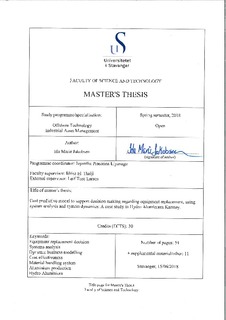| dc.contributor.advisor | El-Thalji, Idriss | |
| dc.contributor.author | Jakobsen, Ida Marie | |
| dc.date.accessioned | 2018-09-13T07:00:31Z | |
| dc.date.available | 2018-09-13T07:00:31Z | |
| dc.date.issued | 2018-06 | |
| dc.identifier.uri | http://hdl.handle.net/11250/2562268 | |
| dc.description | Master's thesis in Offshore technology: Industrial asset management | nb_NO |
| dc.description.abstract | Hydro is a fully integrated aluminium company with employees in countries worldwide. Maintaining equipment that is being used in the production of aluminium is an important and complex task. There are many critical operations in the production process, and the need for functioning equipment with optimal quality is essential.
The maintenance decisions related to repair specific failed components or replace the whole equipment, are today made based on information about the condition of one component and not based on the condition of the whole system. If fact, the managers at the case company (Hydro Aluminium Karmøy) feel that the accumulated repair costs of several components (e.g. pump, motor) within one subsystem (e.g. hydraulic system) might exceed the price of replacing the subsystem or even the whole system (e.g. tapping carriage). However, it is hard to determine whether and when the failed components should be repaired or if the whole subsystem/system should be replaced.
The purpose of this master thesis is to support the repair vs replace decision making process with a predictive and illustrative model, that will help to anticipate and visualise a potential cost-effective maintenance policy that takes the whole system into consideration when maintenance decisions are to be made.
In order to do this, a critical system in aluminium production is selected as a case study and its associated maintenance and failure data is studied. The first step is to identify a critical subsystem and components within the selected system, that are further analysed. The maintenance events and the associated costs of the selected components is established to draw up the maintenance event timeline and use this as inputs for the developed system dynamic model, with the help of a simulation program called Vensim. The program is used to simulate the accumulated maintenance lifetime cost with both a local (repair cost of individual components) and a global (accumulated repair cost of all components) focus, and then comparing it with the cost of buying a new system (replacement cost). The simulated dynamic model would help the case company to make better decisions about e.g. repair vs replace.
First, the predictive model proved that the accumulated cost for maintaining a few components over a short period of time, would approximately reach the cost of replacing the whole subsystem. This supports the fact that a global perspective would be a better maintenance policy, than a local. Second, the predictive model illustrates how to utilize the collected maintenance data in order to learn and perform predictive analytics. This model emphasis the need to have integrated data collection system so that required inputs can be fed into the predictive model. Third, this study show that data quality is significant to predict potential scenarios and support the decision-making process regarding equipment replacement i.e. repair vs replace. High quality data increase the reliability and validity of using this data to learn and predict future patterns and maintenance strategies. In summary, the case study could show the benefit of using predictive simulation model to visualise the potential accumulated maintenance cost at component, subsystem and system levels. | nb_NO |
| dc.language.iso | eng | nb_NO |
| dc.publisher | University of Stavanger, Norway | nb_NO |
| dc.relation.ispartofseries | Masteroppgave/UIS-TN-IMBM/2018; | |
| dc.rights | Navngivelse 4.0 Internasjonal | * |
| dc.rights.uri | http://creativecommons.org/licenses/by/4.0/deed.no | * |
| dc.subject | offshore teknologi | nb_NO |
| dc.subject | industrial asset management | nb_NO |
| dc.subject | equipment replacement decision | nb_NO |
| dc.subject | systems analysis | nb_NO |
| dc.subject | dynamic business modelling | nb_NO |
| dc.subject | cost effectiveness | nb_NO |
| dc.subject | material handling system | nb_NO |
| dc.subject | aluminium production | nb_NO |
| dc.subject | Hydro Aluminium | nb_NO |
| dc.subject | industriell driftsledelse | nb_NO |
| dc.title | Cost predictive model to support decision making regarding equipment replacement, using system analysis and system dynamics: A case study in Hydro Aluminium Karmøy. | nb_NO |
| dc.type | Master thesis | nb_NO |
| dc.subject.nsi | VDP::Teknologi: 500::Marin teknologi: 580::Offshoreteknologi: 581 | nb_NO |

